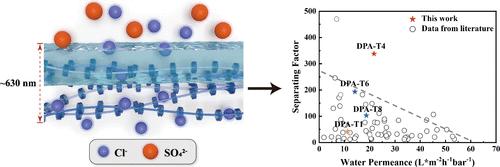基于精密设计的超薄聚乙烯支撑层的具有增强离子选择性的纳滤膜
IF 8.3
2区 材料科学
Q1 MATERIALS SCIENCE, MULTIDISCIPLINARY
引用次数: 0
摘要
纳滤(NF)技术在水处理和分离领域的应用日益广泛。然而,大多数研究都集中在选择层的改进上,而忽略了支撑层的潜在作用。凭借在超薄聚合物薄膜,特别是聚乙烯(PE)膜生产方面的专业知识,我们在这项工作中探索了通过精确控制超薄支撑层的结构和表面特性来提高纳滤膜性能的可能性。在这里,我们介绍了一种创新的纳滤膜,它使用了通过双轴拉伸工艺生产的亚微米级超薄聚乙烯膜,比市场上的商用聚乙烯膜薄得多。其核心创新点如下:首先,我们专注于精确控制支撑层,而不仅仅是选择层,从而显著提高了无负压膜的整体性能;其次,超薄聚乙烯支撑层可作为界面聚合的可调界面,为选择层的结构控制提供了可能性,并推动了膜性能的创新。所制备的 NF 膜总厚度为 630 纳米,是迄今为止最薄的 NF 膜。这种超薄 NF 膜显示出 338.03 的超高 Cl-/SO42- 选择性,在现有文献中处于领先地位。这项研究揭示了支撑层在制备选择性层中的重要作用。我们相信,这种方法有望促进超薄、高性能 NF 膜的开发。本文章由计算机程序翻译,如有差异,请以英文原文为准。

Nanofiltration Membrane with Enhanced Ion Selectivity Based on a Precision-Engineered Ultrathin Polyethylene Supporting Layer
Nanofiltration (NF) technology is increasingly used in the water treatment and separation fields. However, most research has focused on refining the selective layer while overlooking the potential role of the supporting layer. With expertise in ultrathin polymer films, particularly in the production of polyethylene (PE) membranes, we explore the possibility of improving NF membrane performance by precisely controlling the structure and surface properties of the ultrathin supporting layer in this work. Here, we introduced an innovative NF membrane that used a submicrometer ultrathin PE membrane produced through a biaxial stretching process, which is significantly thinner than commercial PE membranes available on the market. The core innovations are as follows: first, we focused on precise control of the supporting layer rather than just the selective layer, achieving significant enhancements in overall NF membrane performance; second, the ultrathin PE supporting layer served as a tunable interface for interfacial polymerization, offering possibilities for structural control of the selective layer and advancing membrane performance innovations. The resulting NF membrane boasts an overall thickness of ∼630 nm, which represents the thinnest NF membrane documented to date. This ultrathin NF membrane showed an ultrahigh Cl–/SO42– selectivity of 338.03, placing it at the forefront of existing literature. This study sheds light on the important role of the supporting layer in the preparation of selective layers. We believe that this approach has the potential to contribute to the development of ultrathin, high-performance NF membranes.
求助全文
通过发布文献求助,成功后即可免费获取论文全文。
去求助
来源期刊

ACS Applied Materials & Interfaces
工程技术-材料科学:综合
CiteScore
16.00
自引率
6.30%
发文量
4978
审稿时长
1.8 months
期刊介绍:
ACS Applied Materials & Interfaces is a leading interdisciplinary journal that brings together chemists, engineers, physicists, and biologists to explore the development and utilization of newly-discovered materials and interfacial processes for specific applications. Our journal has experienced remarkable growth since its establishment in 2009, both in terms of the number of articles published and the impact of the research showcased. We are proud to foster a truly global community, with the majority of published articles originating from outside the United States, reflecting the rapid growth of applied research worldwide.
 求助内容:
求助内容: 应助结果提醒方式:
应助结果提醒方式:


